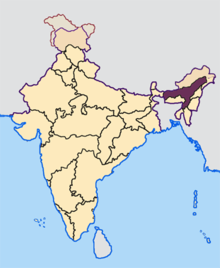Chutia Kingdom
The Chutia Kingdom (1187–1673) (also Chutam, Xodiya, Tiura) was an early medieval state in the present eastern Assam and Arunachal Pradesh. It extended over the present districts of Lakhimpur, Dhemaji, Tinsukia, Dibrugarh, parts of Jorhat, Sibsagar, Sonitpur in Assam; and East Siang, Subansiri, Lower Dibang, Lohit districts in Arunachal Pradesh[4] and controlled the eastward trade and migration of people to and from Tibet, Southern China, and Assam.[5] The Chutia Kingdom fell to the Ahom Kingdom after a series of conflicts in the 16th and 17th centuries.
Chutia Kingdom | |||||||||
|---|---|---|---|---|---|---|---|---|---|
| 1187–1673 | |||||||||
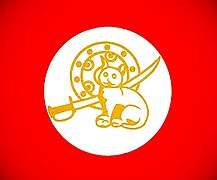 Coat of arms
| |||||||||
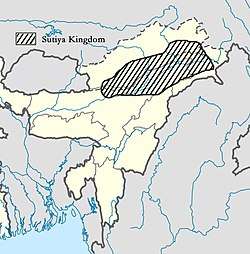 The Chutia Kingdom c. 13th century during the reign of King Gaurinarayan. | |||||||||
| Capital | |||||||||
| Common languages | Deori language, Assamese language | ||||||||
| Religion | Kechai Khaiti, Hinduism | ||||||||
| Government | Monarchy | ||||||||
| Monarch | |||||||||
• 1187–1210 | Birpal (first) | ||||||||
• 1522–1524 | Nityapal (last) | ||||||||
| Historical era | Medieval Assam | ||||||||
• Founded by Birpal | 1187 | ||||||||
• Expansion under Gaurinarayan | 1210–1250 | ||||||||
• Ahom-Chutiya conflict | 1513 – 17th century | ||||||||
• Siege of Sadiya | 17 April 1524 | ||||||||
• Disestablished | 1673 | ||||||||
| |||||||||
| Today part of | India | ||||||||
| Chutiya dynasty | |
|---|---|
| Part of History of Assam | |
 | |
| Rulers of the Chutiya kingdom (1189 - 1524) | |
| Birpal | 1189–1220 |
| Ratnadhwajpal | 1220–1250 |
| Vijayadhwajpal | 1250–1270 |
| Vikramadhwajpal | 1270–1285 |
| Gauradhwajpal | 1285–1305 |
| Sankhadhwajpal | 1305–1325 |
| Mayuradhwajpal | 1325–1343 |
| Jayadhwajpal | 1343–1360 |
| Karmadhwajpal | 1360–1380 |
| Satyanarayan | 1380–1400 |
| Lakshminarayan | 1400–1415 |
| Durlabhanarayan | 1415–1430 |
| Muktadharmanarayan | 1430–1445 |
| Pratyashnarayan | 1445–1465 |
| Yasnarayan | 1465–1480 |
| Purandharnarayan | 1480–1500 |
| Dharmadhwajpal | 1500–1522 |
| Nityapal | 1522–1524 |
| Chutia monarchy data | |
| |
| |
| |
| |
| |
| |
| |
| Part of a series on the |
| Culture of Assam |
|---|
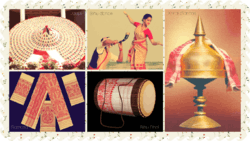 |
|
Proto-historic
Classical Medieval
Modern |
|
|
|
Festivals
|
|
Religion Major
Others |
|
History
Archives
Genres
Institutions Awards |
|
Music and performing arts |
|
Media |
|
Symbols
|
Among the Chutia kings was Gaurinarayan (Ratnadhwajpal), son of Birpal the legendary founder of the kingdom. He brought many other Chutia groups into his kingdom. In 1224, Ratnadhwajpal defeated another Chutia king named Bhadrasena, the king of Swetagiri, and conquered the area between Subansiri and Sissi rivers, i.e. present-day Dhemaji district. In 1228, he went on another campaign to further expand his kingdom and subjugate the Chutia king Nyayapal (ruling the areas between Biswanath and Subansiri,i.e. present-day Biswanath and Lakhimpur districts) and marched toward Kamatapur, where he formed an alliance with the Kamata ruler by marrying a princess. Then he marched to Dhaka, and made friends with the Gauda ruler.
The hostilities with the Ahoms began when the Chutia Kingdom expanded to the south during which the Ahom king, Sutuphaa, was killed by the Chutia king during a friendly negotiation. This conflict triggered a number of battles between the two sides which saw the great loss of men and money. The simmering dispute often flared till 1524 when the Ahoms struck the Chutia Kingdom at its weakest state, took Sadiya and killed the then king, Nityapal. The Ahoms established their rule by instituting the position of Sadiyakhowa Gohain, a newly constituted position of frontier-governor in charge of Sadiya. But the Chutia had dispersed to frontier regions, and continued raids against the Ahoms. It finally ended in 1673 when they fell under the domination of the Ahoms.
Origin
The Chutia people belong to the Boro-Garo linguistic group, one of the Bodo-Kachari peoples.[6] Chutias are inhabitants of Upper Assam who established political power in Sadiya and adjoining areas falling within modern Arunachal Pradesh.[7] Birpal was one of the numerous Chutia chieftains who ruled present-day Upper Assam and Arunachal Pradesh. Over the years he and his successors united all the Chutia kings of Assam and Arunachal Pradesh in the hills and plains to form the Chutia kingdom . It was the largest kingdom in Assam before the rise of Ahom kingdom. The kingdom and reigned for over 400 years in eastern Assam and Arunachal Pradesh with its capital at Sadiya and Ratnapur. Swadhyadhipati/Sadhayapuriswar is the Assamese name for the king of the Chutias. Sadhayāpurī (or Svadhayāpurī) or Sadiya was the name of the kingdom as well its capital.[8] It became the dominant power in eastern Assam in the 12th century and remained so until the 16th century with its domain from Parshuram Kund in the east to Vishwanath[9] in the west.[10]
History
Foundation (1189)
The founder of the Chutia kingdom was Birpal who claimed descent from a legendary king named Bhirmukka[11] and reigned in 1189. He ruled over 60 clans with his capital on a hill called Swarnagiri and assumed the title of Gayapal. He was succeeded by his son Sonagiripal assuming the title of Gaurinarayan.[12]
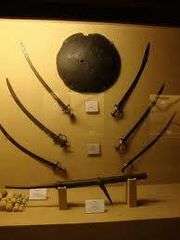
Expansion (1224–1250)
Gaurinarayan, alias Ratnadhwajpal, was one of the most competent Chutia kings. He brought under his sway the neighbouring Chutia principalities of Rangalgiri, Kalgiri, the Nilgiri, the Chandragiri, the Dhavalgiri and many others. He conquered the whole northeastern region of Assam which included the areas of present-day Arunachal Pradesh and assumed the title Chatra-dhari.[13] In around 1230 AD, with a large army, he attacked and defeated another Chutia king, Bhadrasena, ruler of the Swetagiri and placed his son as a vassel chief. In the expedition, he gained rich booty and many prisoners of war belonging to the Brahmin, Tanti, Sonari, Sutar and Kumar classes whom he settled in various parts of the kingdom. He built his capital at Ratnapur (Majuli), hence also called Ratnadhwajpal and used certain techniques to advance the agricultural system in the kingdom. The neighboring Chutiya king, Nyaya Pal surrendered with costly gifts even before he was attacked. To cement the alliance, he married the daughter of Nyayapal. He built a line of forts along the foot of the hills against inroads by the hill tribes and built large tanks and temples for his people. In Kamatapur, when Kamateswar refused his daughter for one of the Gaurinarayan sons, the king marched against him, constructing a road with forts at certain intervals. Alarmed at the energy displayed by his troops, Kamateswar agreed to give one of the princesses in marriage to the Chutia prince.[12]
These expeditions by Gaurinarayan took Chutia Kingdom to supremacy to such an extent that after a few years the impact of his power was felt even by the Gauda ruler. The Gauda ruler, possibly Keshava Sena, made friends with Gaurinarayan who sent one of his sons to that country to be educated. Unfortunately, the Chutia Prince died there and the corpse was sent to Gaurinarayan, who was then engaged in building a new city. He named the city as Sadiya (Sa-Corpse, Diya-Given) which later on became the capital of the Chutia Kingdom. Extensive remains of buildings and fortifications built during the rule of the Chutias near about Sadiya still point to the importance of the region in the past.
Chutia-Ahom conflicts (1512–1522)
The conflict between the Chutias and Ahoms started when Suhungmung annexed the Chutia principalities of Habung and Panbari[14] in 1512 AD.[15] The then Chutia king Dhirnarayan decided to attack the Ahom kingdom to prevent any further expansion. So, the following year Dhirnarayan, along with an army, sailed down the Dihing river and built a stockade of banana trees (Posola-garh) on the bank of the Dikhowmukh. A selected body of soldiers was stationed at a place near the Nongkongmung lake while another unit was dispatched with the navy to Shira-ati. The Chutia generals were Manik-Chandra Borua, Borhuloi Borua and Dhela Bora while the Ahoms were led by Chao Shukhring and two Railungia Gohains. A pitched battle was fought in which a large number of soldiers were killed. The Ahoms achieved victory in the battle and took possession of Mung-khrang (Dihingmukh region) and a part of trans-Namdang region. In total about 5,000 Chutia men were killed in the battle.[16] Suhungmung ordered a township to be built in the newly acquired territory.[17] After this defeat, Dhirnarayan reorganised his army and attacked the Ahom fort in Dihing-mukh in the year 1520 AD.[18] The Ahom commander Khenmung was killed and his whole garrison fled. Thus, the areas of Mung-khrang, Habung, Panbari once again came under Chutia rule.[19] But, soon Dhirnarayan died and the reign of the kingdom was passed to the son-in-law named Nitipal who was weak and inefficient in ruling.
Downfall (1522–1524)
The kingdom saw its weakest state under Nityapal, the husband of Dhirnarayan daughter Sadhani. In 1522, Dhirnarayan due to his growing age passed down his throne to Nityapal. The Chutia nobilities and ministers resisted the decision of giving away the throne to Nityapal. Many other vassal chiefs of Lakhimpur, Majuli, Biswanath became independent and were eventually annexed by the Ahoms. In the same year, Suhungmung came near the Nongkongmung lake and sent his men to attack the Chutias in Dihingmukh. The Borgohain took leadership in the battle and pushed the Chutias northwards from Shup-Nam-Jon(Dihingmukh).[20] He sent a general named Lashaitai to meet the king, in a bor-nao (boat) obtained from the Chutias.[21] By that time, Suhungmung had come to a place named Cheruakata (Majuli). Lashatai met Suhungmung, who ordered him to fight with the Chutias stationed at Shup-Tiphao(Dibrumukh) river.[22] The Ahom king himself collected a great army and sailed to Dibrumukh. The Chutias were defeated there and retreated. In the month of Kati (1523 AD), Phrasengmung Borgohain and general Klinglun with their whole force, proceeded to the mouth of the Dibru river and constructed a fort (Dibrugarh) there. Suhungmung returned to Charaideo and offered sacrifices to the gods. In the next month Aghun, he stationed his forces at Shup-Shing-sa(Sessamukh). Nitipal at that time advanced from Sadiya to Larupara(Chabua). From there, he sent his army to Dibrugarh to fight with the invaders. The Chutia generals in this battle were Toktoru, Kasitara, Chuluki Chetia and Borpatra. Suhungmung hurried to the spot with strong reinforcements and routed the Chutias. The invading army then penetrated as far as Sonari (Kakopathar), when Nitipal sent Katakis (messengers) to the Ahom king along with gifts which included gold bedstead (ku), gold earrings (khao), gold-embroidered cloth (kham-sin) and stone-cut Xorai (phra-kha-phun) in order to settle for peace. In reply, Suhungmung asked for the Chutia royal heirloom (gold cat, gold and silver umbrella, royal bedstead and scepter) along with elephants and a girl. Nitipal agreed on sending the elephants and the girl, but did not give the royal heirloom as it belonged to his ancestors. Instead, after a month, he sent other gifts like gold and silver-gilded Jaapi (Kham-Ngiu-Kup), gold ring (Khup-kham), gold basket(Liu-kham), gold umbrella(Chang-kham), gold bookstand (Khu-tin-kham), golden bracelets (Mao-kham), Xorai, elephants, horses, ivory-mats, knives and Panikamoli cloth and started building a fort on the banks of Lohit river.[23] The Ahom king took the knives and the building of the fort as a sign of war and attacked Sadiya during Bohag month of 1524.[24]
The sudden attack at Sadiya (Che-lung) during Bihu forced the king and queen along with some of the soldiers who survived, to flee to the hills situated above Sadiya. Kasitora(mentioned as Kaitora) was chased by the Dhanudhari Gohain(Chao-Song-Kung-Rin) Klangseng[25] and a battle was fought in Doithang hill. The king and his men took shelter in Chandangiri hill(Doi-Chantan). The Chutias attacked valiantly against the invaders from the hills. They applied gurella warfare strategies and used Faakdhenu (crossbows) and spears. The army killed hundreds of enemies. The queen Sadhani formed a female fighting squad of 120 warriors. They assisted the army by rolling big boulders onto the enemy below. The invaders were unable to do anything. That day was 21 April (7th Bohag) and was widely considered as Ujha (Drummer's) Bisu. Therefore, one of the former ministers of the Chutias whom Nitipal had removed sided with the Ahoms and suggested the Ahom commander Phrasengmung Borgohain to play the Dhol. Thus the general ordered some captives to climb up Ghila creepers and play the Bihu drum or Dhol.[26] As it was the season of Bihu, the Chutia army took it to be a sign that re-enforcements had arrived from other parts and that it was a sign of victory, thinking the Ahoms were chased out. So, thinking the drum beats to be a signal of victory they came down to the lower hills where the enemies were hiding. Another former Chutia commander named Gajraj Borua who had sided with the Ahoms showed the enemies the exact way to the location where the king was hiding.[27] The king was attacked and killed by an arrow while the queen gave her life by jumping from the hill-top.
Aftermath (1524–1525)
After killing the Chutia royals, Chao-Cheng-Kung-rin Klangseng offered the severed head of the Chutia king and Kasitora to Suhungmung in Sadiya. Phrasengmung Borgohain was made the Sadiya-khowa gohain(Chao-bo-ngen) and given three thousand men along with three elephants.[28] To strengthen the rule, the Ahoms set up colonies in Sadiya as well as on the banks of the Dihing river.[29] The Ahom king then returned to Charaideo, performed the Rikkvan ceremony and ordered the heads of the Chutia royals to be buried at the base of the stairs attached to the Deoghars. A new capital was built in Bakata on the banks of Dihing river. A number of Brahmins, artisans like blacksmiths(Komar), goldsmiths(Sonari), potter(Kumar), weavers(Tanti), masons(Khanikar), carpenter (Barhoi) were deported from Sadiya to the new capital. A lot of precious articles and valuable products were recovered from the Chutia country and sent via boats through the Dihing river to the capital. These included gold dishes (Maihang), royal palanquin (Kekura-Dola), the gold throne (Hunor tinisukia hinghakhan), gold bedstead (Khat), gold kettles (Bhug-jara), gold foot-tub (Bela) gold embroidered wicker hats (Jaapi), gold spittoon(Pikdan), royal shade (Aruwan), big-drums (Doba), trumpets (Kali) gun-boats (Hiloi-chara-nao), weapons like hand-cannons (Hiloi), large cannons ( Mithahulung), Chutia bow (Faak-dhenu), Long-bow (Bor-dhenu), gunpowder (Barud), spears (Barsa) as well as cattle, elephants and horses. Upon annexing the Chutia territories, the Ahoms came in contact with hill tribes like Miris, Abors, Mishmis and Daflas. The newly acquired territories were divided among the Buragohain and Borgohain, while new offices were created to administer the country more efficiently. These included Thao-mung Mung-teu(Bhatialia Gohain)[30] with headquarters at Habung (Lakhimpur), Thao-mung Ban-lung(Banlungia Gohain) at Banlung (Dhemaji), Thao-mung Mung-klang(Dihingia gohain) at Dihing (Dibrugarh and northern Sibsagar) and Chaolung Shulung at Tiphao (northern Dibrugarh).[31][32] In 1527, a new ministerial position named Borpatrogohain was created (borrowed from the Chutia Vrihat-patra),[33] and Klangseng(previously posted as Bhatialia Gohain) was given charge.[34][35]
Rebellions (1525–1673)
Although the Ahoms annexed the Chutia territories, a number of Chutias went to the countryside where they were still in power and continued their fight against the Ahoms to reclaim their lost territories. The conflict went on for the next 150 years until it finally ended in 1673 when the Chutias fell under the domination of the Ahoms and were absorbed into their state.[12]
Geography
The Chutias held the areas to the north of Brahmaputra from Parshuram Kund in the east to Vishwanath in the west which represents the areas of Dhemaji district, Lakhimpur district and Sonitpur district of present Assam.[36] To the north, it controlled the present Miri Hills, Abor Hills and the Mishmi Hills (Rangalgiri, Kalgiri, Nilgiri, Chandragiri, Dhavalgiri)[37] in the state of Arunachal Pradesh. To the south of the Brahmaputra, it had parts of Dibrugarh district, Sibsagar district and almost the entire Tinsukia district under its rule.[4]
Rulers (1187–1524)
| # | Years | Reign | Name | Other names |
|---|---|---|---|---|
| 1 | 1187–1210 | 23 y | Birpal | Gayapal |
| 2 | 1210–1250 | 40 y | Ratnadhwajpal | Gaurinarayan |
| 3 | 1250–1270 | 20 y | Vijayadhwajpal | Shivanarayan |
| 4 | 1270–1285 | 15 y | Vikramadhwajpal | Jagatnarayan |
| 5 | 1285–1305 | 20 y | Gauradhwajpal | Pramattanarayan |
| 6 | 1305–1325 | 20 y | Sankhadhwajpal | Harinarayan |
| 7 | 1325–1343 | 18 y | Mayuradhwajpal | Goluknarayan |
| 8 | 1343–1360 | 17 y | Jayadhwajpal | Brajnarayan |
| 9 | 1360–1380 | 20 y | Karmadhwajpal | Nandeshwar |
| 10 | 1380–1400 | 20 y | Satyanarayan | Ratnanarayan |
| 11 | 1400–1415 | 20 y | Lakshminarayan | Dharmanarayan |
| 12 | 1415–1430 | 15 y | Durlabhanarayan | |
| 13 | 1430–1445 | 15 y | Muktadharmanarayan | |
| 14 | 1445–1465 | 20 y | Pratyakshnarayan | |
| 15 | 1465–1480 | 15 y | Yakshnarayan | |
| 16 | 1480–1500 | 20 y | Purandarnarayan | |
| 17 | 1500–1522 | 22 y | Dharmadhwajpal | Dhirnarayan |
| 18 | 1522–1524 | 2 y | Nityapal | Chandranarayan/Nitai |
References
- "639 Identifier Documentation: aho – ISO 639-3". SIL International (formerly known as the Summer Institute of Linguistics). SIL International. Retrieved 29 June 2019.
Ahom [aho]
- "Population by Religious Communities". Census India – 2001. Ministry of Home Affairs, Government of India. Retrieved 1 July 2019.
Census Data Finder/C Series/Population by Religious Communities
- "Population by religion community – 2011". Census of India, 2011. The Registrar General & Census Commissioner, India. Archived from the original on 25 August 2015.
- Gogoi, Punyadhar (2006). War Weapons in Medieval Assam. Concept Publishing. pp. 20–21.
- (Saikia 2004:8)
- (Shin 2020:51) The Chutias belong to the Bodos, a linguistic group of the Brahmaputra valley, speaking a Tibeto-Burman language and having different cognate groups within them
- (Shin 2020:51) inhabitants of the hills to the north of the Brahmaputra, perhaps the north-western portion of the Dibang valley. Moving down from the hills to the plains of upper Assam, at some point of time before the entry of the Shans, a Tai ethnic group of Southeast Asia, the Chutias seem to have assumed political power in Sadiya and contiguous areas falling within modern Arunachal Pradesh
- (Shin 2020:53) Nandin and Satyanārāyaṇa ruled Sadhayāpurī in the latter half of the fourteenth century, while Lakṣmīnārāyaṇa belonged to the beginning, and Dharmanārāyaṇa to the middle of the fifteenth century. It is also nearly clear that Sadhayāpurī (or Svadhayāpurī) mentioned in the inscriptions is the same as Sadhiyā or Sadiya of later times
- Prakash 2007, pp. 913.
- (Acharya 1966:232)
- (Bhuyan 1962:134) The Deodhai Buranji mentions Birpal to be a descendant of Bhirmukka. It also reads "Sadiya Korjaku-Desha Chutika-Bansha Bhirmukka".
- Prakash 2007, pp. 267.
- (Bhuyan 1962:135)
- Some Buranjis like PAB and DAB mention Panbari to be a part of Habung
- A Chutia chief named Vrihat-patra referred to as Habung-adhipati is mentioned in the copper plate of Dharmarayan dated to 1428 AD.
- Assam Buranji(SM), p.9
- (Bhuyan 1962:15–16)
- Purani Assam Buranji, p.40
- The copper plate inscription of land grant found in Dhakuakhana(formerly Habung) indicates that king Dhirnarayan donated 4000 bighas of land in the year 1522 AD to Brahmins
- Nam-jin/jon is the Tai equivalent of Dihing
- (Bhuyan 1962:17)
- Purani Assam Buranji,p.40
- (Barua 1939:56)
- (Wade 1927:24)
- Klangseng is mentioned as Chao-Cheng-Kung-rin
- (Bhuyan 1962:200)
- (Bhuyan 1960:10)
- (Acharya 1966:88)
- (Gait 1963:86)
- Chao-Cheng-Kung-rin Klangseng was made the first Bhatialia Gohain
- (Gait 1963:8)
- (Barua 1939:59–61)
- (Guha 1983:20)
- Thao-mung mungteu(Bhatialia Gohain) was made Chao-sheng-lung in Lakni Rungrao 1527.(p.61.)
- Klangseng is mentioned as Chao-sheng-lung in Lakni Dapplao 1531.(p.64)
- (Datta 1985:28)
- Prakash 2007, pp. 911–916.
- (Neog 1977:817) Light on a ruling dynasty of Arunachal Pradesh in the fourteenth and fifteenth centuries
- Barua, S.L. Chutia Jatir Buranji. 2004, p. 107.
Bibliography
- Shin, Jae-Eun (2020). "Descending from demons, ascending to kshatriyas: Genealogical claims and political process in pre-modern Northeast India, The Chutiyas and the Dimasas". The Indian Economic and Social History Review. 57 (1): 49–75. doi:10.1177/0019464619894134.
- Guha, Amalendu (1991), Medieval and Early Colonial Assam: Society, Polity and Economy, K.P. Bagchi & Co, Calcutta
- Guha, Amalendu (December 1983), "The Ahom Political System: An Enquiry into the State Formation Process in Medieval Assam (1228-1714)", Social Scientist, 11 (12): 3–34, doi:10.2307/3516963, JSTOR 3516963
- Saikia, Yasmin (2004). Fragmented Memories: Struggling to be Tai-Ahom in India. Duke University Press. ISBN 082238616X.
- Baruah, S L (1986), A Comprehensive History of Assam, Munshiram Manoharlal
- Prakash, Col. Ved (2007), Encyclopedia of North East India, 2, Atlantic Publishers & Dist.
- Pathak, Guptajit (2008), Assam's history and its graphics, Mittal Publications
- Bhuyan, Suryya Kumar (1960). Assam buranji,from an old manuscript obtained in the family of the late Srijut Sukumar Mahanta of North Gauhati (in Bengali). Government of Assam in the Department of Historical and Antiquarian studies.
- Baruah, Swarna Lata (1997). A Comprehensive History of Assam. Munshiram Manoharlal Publishers. ISBN 978-81-215-0015-9.
- Bhuyan, Surya Kumar (1962). Deodhai Asam Buranji: with several shorter chronicles of Assam (compiled from old Assamese buranjis) (in Assamese).
- Acharya, Nagendra Nath (1966). The History of Medieval Assam, from the Thirteenth to the Seventeenth Century (PDF). Dutta Baruah. Archived from the original (PDF) on May 2020.
- Wade, J. P. (1927). Sharma, Benudhar (ed.). An account of Assam. R. Sarmah.
- Neog, Maheswar (1977). "Light on a Ruling Dynasty of Arunachal Pradesh in the Fourteenth and Fifteenth Centuries". Annals of the Bhandarkar Oriental Research Institute. 58/59: 813–820. ISSN 0378-1143. JSTOR 41691751.
- Neog, Maheswar Ed (1974). Prachya-sasanavali. Assam Prakashan Parisad, Guwahati.
- Datta, S (1985). Mataks and their Kingdom (PDF).
- Gait, Sir Edward Albert (1963). A History of Assam. Thacker, Spink.
- Barua, G.C. (1939). Ahom Buranji.
